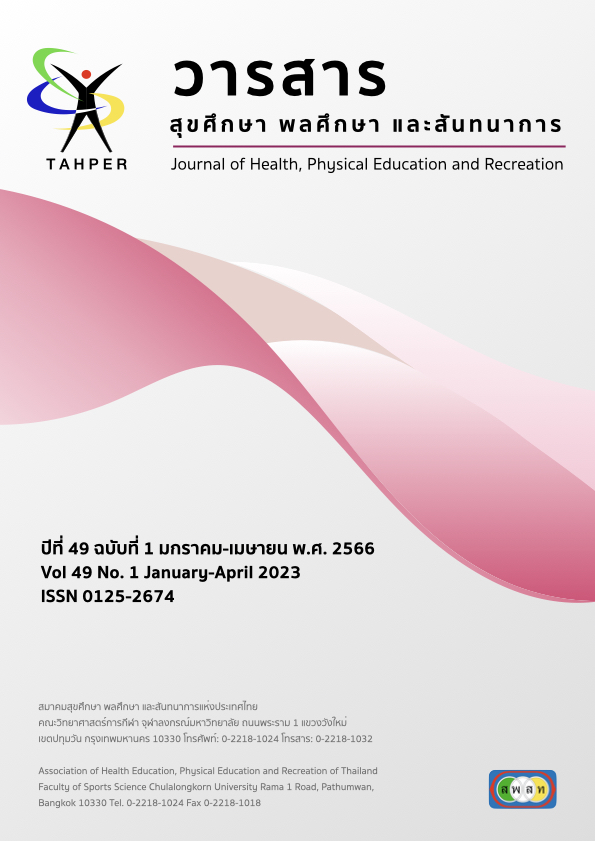Factor Affecting in Roundhouse Kicks Performance of Youth Taekwondo Athletes
Main Article Content
Abstract
The purpose of this study was to predict the roundhouse kick performance of youth taekwondo athletes. 385 participants who was 15-17 years old, was a youth taekwondo athlete competing in taekwondo competition in Thailand. Measure was 1) the Modified Revised Competitive State Anxiety Inventory-2: MCSAI-2R of Thai version was including 12 items for the direction and intensity anxiety; 2) the Roundhouse Kick Self-Efficacy Scale of Thai version was 12 items; 3) a number of the roundhouse kick report; and 4) a long length measure of arm and leg record. Research procedure was the athletes complete a questionnaire around 30 minutes to 1hours before the match and measure long length of hand and leg. Moreover, researcher will record a number of roundhouse kick in which conduct a score from that kick between the matches. Data analysis was stepwise – multiple regression analysis.
The result found that youth taekwondo athlete hand had long length was 61.18±4.02 centimeters, and leg long length was 108.09±5.97 centimeters. Participant was both medium of somatic intensity anxiety (× = 15.70±3.54) and cognitive intensity anxiety (× = 14.79±3.47). The direction of anxiety was dropped on the poor side in both of somatic anxiety (× = -1.246±6.28) and cognitive anxiety (× = -2.35±5.35). Pearson’s correlation shows all factors were significant correlation at .05. The arm long length, roundhouse kick efficacy, and experience was a good factor for equation prediction a roundhouse kick performance follows as = -9.268+0.204(X1)+0.076(X4)+0.254(X5). In conclusion, athlete must get more competition experience and increased self-efficacy, moreover, used arm long length use for checking the distance.
Article Details

This work is licensed under a Creative Commons Attribution-NonCommercial-NoDerivatives 4.0 International License.
Critical thinking in journals is the right of the author. The Association of Health Education, Physical Education and Recreation of Thailand is not always required, to create diversity in ideas and creativity.
ความคิด ข้อวิพากษ์ในวารสารเป้นสิทธิของผู้เขียน สมาคมสุขศึกษา พลศึกษา และสันทนาการแห่งประเทศไทยไม่จำเป็นต้องเห็นชอบด้วยเสมอไป เพื่อให้เกิดความหลากหลายในความคิดและความสร้างสรรค์
References
กรมพลศึกษา กระทรวงการท่องเที่ยวและกีฬา. (2556). จิตวิทยาการกีฬา. กรุงเทพฯ: สำนักงานกิจการโรงพิมพ์องค์การสงเคราะห์ทหารผ่านศึกในพระบรมราชุปถัมภ์.
กรมพลศึกษา กระทรวงการท่องเที่ยวและกีฬา. (2556). คู่มือผู้ฝึกสอนกีฬาเทควันโดตามหลักสูตรมาตรฐานวิชาชีพผู้ฝึกสอนกีฬาเทควันโด.กรุงเทพฯ: ศูนย์สื่อและสิ่งพิมพ์แก้วเจ้าจอม มหาวิทยาลัยราชภัฎสวนสุนันทา.
สุพัชรินทร์ ปานอุทัย. (2553). ความเข้มและทิศทางของความวิตกกังวลของนักกีฬาก่อนการแข่งขัน. วิทยาสารกำแพงแสน, 8(1), 32
สุริยัน สมพงษ์ วิมลมาศ ประชากุล และสุพิตร สมาหิโต. (2554). การสร้างแบบวัดความเข้มแข็งทางจิตใจสำหรับนักกีฬาเทควันโด. วารสารวิทยาศาสตร์และเทคโนโลยีการกีฬา, 11(2), 255-268.
Devenport, T. (1997). Perceptions of the contribution of psychology to success in elite kickboxing. Journal of Sport Sciences and Medicine, CSSI, pp. 99-107.
FALCO C., ALVAREZ O., CASTILLO I., ESTEVAN I., MARTOS J., MUGARRA F., IRADI A., Influence of the distance in a round- house kick's execution time and impact force in Taekwondo, J. Biomech., 2009, Vol. 42(3), 242–248.
LEE S., Frequency analysis of the Taekwondo techniques used in a tournament, J. Taekwondo, 1983, Vol. 46, 122– 130.
Jerzy Sadowski1ACD, Dariusz Gierczuk1BD, Jerzy Miller2BE, Igor Cieśliński. (2012). Success factors in elite WTF taekwondo competitors. SCIENCE OF MARTIAL ARTS, 8(3), pp. 141-146.
Kim, J., Kim, J., Lee, S., Han, K., and Kwon, MS. (2013). ARM MOTIONS FOR DIFFERENT TARGET POSITIONS DURING TAEKWONDO ROUNDHOUSE KICKS. 31 International Conference on Biomechanics in Sports (2013) /Coaching and Sports Activities.
Yun YK, Kim WB, Lim TH. Analytic Hierarchy Process to Examine Factors Influencing Sports Performance. K J Sport Psych. 2006;17(1):1–11.


